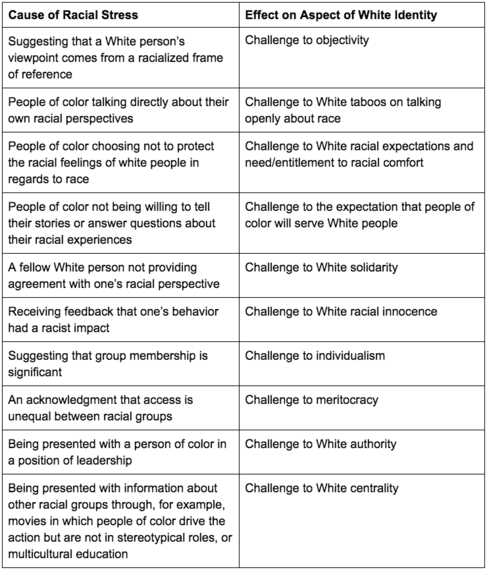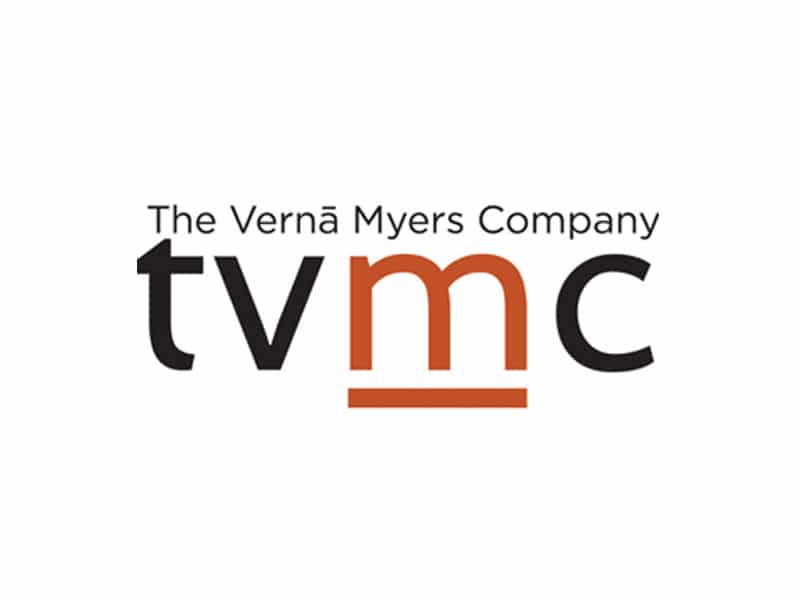By Anna Kegler
For a while now, I’ve been thinking about how terms like “white privilege,” “inclusion” and “unconscious bias” all sound just… too nice. Don’t they seem a little on the pleasant side for words used to address a system of racist oppression? It reminds me of how, in Minnesota in January, the meteorologists will say it’s going to be a “cool evening” as they stand in front of a map showing temperatures that will literally freeze your nostrils together when you take a breath.
Something’s definitely up.
I’m reminded of how, in the novel 1984, the creepy futuristic government acts as if it’s “Opposite Day” all the time, using the Ministries of Love, Peace, Plenty and Truth to handle fear, war, rationing, and propaganda. The deliberate distortion of words is called doublespeak and we actually see it frequently in real-life politics (for example, the Clear Skies Act makes it easier to pollute the air and “enhanced interrogation“ means old-fashioned torture). Words are powerful.
The language we use to talk about racism is obviously distorted, a big clue that something is being hidden. It’s pretty easy to pinpoint the source: most White people can’t handle talking about racism. We flail. We don’t understand the subject, we get really uncomfortable, and we either clam up because we don’t want to say the wrong thing, or we bust out the whitesplaining (FYI, this is a best-case scenario. It can be much worse).
To mitigate our shortcomings, we surround ourselves with comforting words. Words that feel neutral. Words that don’t point fingers (at us). Words that center Whiteness, while erasing the harshness of discrimination and segregation. We reject words that we feel are too direct, that might reveal complicity on our part.
Let’s be clear that these linguistic gymnastics are only fooling White people. People of color have been aware that corporate pushes for “diversity” are often flimsy CYA efforts to mask sustained homogeneity, and “inclusion” is often code for tokenism. Scholars of color have been writing about the nuances of privilege and oppression for a long, long time while watching White people invent different ways to either wriggle out of, dominate, or shut down the conversation. These same scholars have also been watching White writers and educators whisper the same exact thing they’ve been shouting, and magically draw a crowd.
I am writing this piece with the understanding that some White people will be more likely to listen to me because I am White. This is part of the underlying problem of White Fragility. White Fragility is the thing that restricts our knowledge, shuts down conversations before they start, and invites us to lie to ourselves. I’ll get into it more in the next section.
Finally, while I do want to nerd out a little dissecting some of the words we use, this piece is not about proposing new language. Our language is just a symptom. The underlying White Fragility is the problem we need to fix.
White Fragility: Living in a Bubble and Also Being in Everyone’s Business
Dr. Robin DiAngelo, a White critical racial and social justice educator who created the term “White Fragility,” breaks it down like this:
White people in North America live in a social environment that protects and insulates them from race-based stress. This insulated environment of racial protection builds white expectations for racial comfort while at the same time lowering the ability to tolerate racial stress, leading to what I refer to as White Fragility. White Fragility is a state in which even a minimum amount of racial stress becomes intolerable, triggering a range of defensive moves. These moves include the outward display of emotions such as anger, fear, and guilt, and behaviors such as argumentation, silence, and leaving the stress-inducing situation. These behaviors, in turn, function to reinstate white racial equilibrium.
Here is a list of things that cause White people racial stress, and why:

As an illustration of the above, let’s look at Donald Trump. Trump is known for speaking in vague generalities and declaring simplistic solutions for complex problems. He avoids policy and fact-based conversations, and gets angry and disgusted at the drop of a hat. Now imagine that when it comes to conversations on race, White people in America act a lot like Donald Trump. We generally lack knowledge, but we always have an opinion. We lack the skill set for nuanced conversations, so we pretend they aren’t necessary. When we can’t avoid, we deflect, or we get upset. We’re thin-skinned.
There are a lot of reasons White people have such a low threshold for discomfort. For one, we tend to lead segregated lives, and we think of ourselves as individuals as opposed to members of a group. We receive constant messages that Whiteness is valuable, and we’re used to feeling a sense of belonging in most spaces. All of this leads to a huge sense of entitlement to being not only comfortable, but correct, at all times. And even once we get exposed to the existence of these dynamics, we are often at a loss as to how to talk about it. We do everything to avoid talking about race in any real way, including saying nonsense like “Mohammad Ali transcended race” when we really mean “was retroactively deemed safe by fragile white people.”
Linguistic Tricks to Outsmart Racial Stress Triggers
Terms like “inclusion” and “white privilege” are designed to sneak past the racial stress triggers of White Fragility. They center Whiteness in a way that makes White people comfortable, while deflecting from the stressful realities of the racist harm that Whiteness causes. Imagine how many racial stress trigger alarm bells would go off if we were using words like “discrimination awareness” and “white undeserved advantages” instead.
Our overly-pleasant terms are the spoonful of sugar that makes the medicine go down. When you’re sick, do you still need a spoonful of sugar? Probably not, because you understand how medicine works. You’ll expect some bitterness, and be fine with it, because you want to get better.
The person who needs a spoonful of sugar doesn’t even know they need it. They have not developed an understanding of why they feel bad or what will fix it. If the medicine doesn’t taste good, they’ll spit it out. They’ll wonder, “why are you punishing me with this terrible tasting thing?” And then the next time, you better be really slick with the sugar, because if they suspect you’re trying to hide bitterness, even if they really, really want to feel better, they’ll clamp their teeth shut. Once they’re on to you, oops, it’s time to be more creative.
I’m going to run through a few terms and briefly outline some thoughts on the relative “sweetness” of the terminology, and the degree to which White audiences have caught on to the sleight of hand. While I might throw out some examples of alternate terms for the purpose of contrast, I’m not seriously trying to propose new terms here. White Fragility has to shift before the language can shift. To start effecting that shift, we can think more critically about what words we’re using now, and why.
Diversity
The word “diversity” is really common when people are talking about hiring. It started out as a neutral word meaning “variety” that’s supposed to describe a group, but somewhere along the way people started referring to individual people as “diverse”, like “we’re looking for a diverse candidate for this role.” So “diverse” is now code for “person of color” or “woman.” It’s been really distorted and linked to a destructive binary related to ability: “diversity” is associated with “lowering the bar.” So “diverse = person of color/woman = low ability” and “not diverse = White man = high ability.”
This word is really a mess. Ava Duvernay was just talking about how much she hates it because it’s a “medicinal word with no emotional resonance.” It’s interesting that she uses the word “medicinal” because this word has been around long enough that there’s not enough sweetness to fool anybody anymore.
White supremacy
Things we call “supreme”: The most delicious desserts. The most well-known and glamorous Motown singers. The highest court in the land. Um… God.
It has bothered me for years that linguistically, white supremacy sounds kind of great. Almost holy. It would sound more appropriately scary if it were called something actively negative, like “White domination” or “White oppressorship.” Once again, imagine the White stress level skyrocketing.
Some disambiguation is necessary with this term. “White supremacy” is a system that prioritizes whiteness regardless of the presence or absence of racial hatred, but a “white supremacist” is a person who embraces overt racial hatred. It’s like a spectrum. By default, all White people are on the spectrum of complicity in upholding a system of White supremacy, but we only give the negative label of “White supremacists” to the really hateful people at the far end. This allows the rest of us to say “we’re not them.”
White privilege
White privilege is a term popularized by Peggy McIntosh, a White women’s studies professor at Wellesley in the late 1980s. While “white privilege” is the term that stuck, many scholars and feminists of color – bell hooks, Kimberlé Williams Crenshaw, Patricia Hill Collins – had been discussing the same ideas, particularly in the context of intersectionality. The discussion also goes back to Sojourner Truth and Anna Julia Cooper, who were discussing racism and sexism as two separate kinds of oppression in the late 1800s. When we ask ourselves why “white privilege” was so catchy among White people, it’s pretty obvious. As Ta-Nehisi Coates said in a recent interview, it’s “a word that we have created to make white people comfortable.”
Hua Hsu, Vassar College professor of English, has a great way of describing this: “Like the robot in a movie slowly discovering that it is, indeed, a robot, it feels as though we are living in the moment when white people, on a generational scale, have become self-aware.” The term “white privilege” is an extremely gentle way of easing White people into awareness. The use of the word “privilege” conjures up images of wealth, something Americans typically associate with merit. As I mentioned earlier, the term easily could have been something like “White undeserved advantages” but that would only serve to shut down conversation if the listener is a fragile White person.
Inclusion
As attorney, educator, and nationally recognized expert Vernā Meyers says, “diversity is being invited to the party, inclusion is being asked to dance.” So “diversity” is the hiring part, and “inclusion” is the “making sure your employees don’t find themselves in a hostile environment and leave“ part (companies are now pairing “inclusion” with “diversity” and calling it “D&I”). The thing that bugs me about “inclusion” is that it sounds like a neutral word but it’s not. It begs the question: “Who is including who? Who does this space belong to?” It sounds like an act of welcoming instead of everyone being on equal footing. And I guess that is what’s happening: predominantly White spaces are trying to be more welcoming, without having to relinquish White ownership of the space. “Inclusion” sounds a lot like a cousin of “All Lives Matter.”
Read full article at Huffington Post


